Functional Overview
Nuxeo Drive is a Nuxeo addon that enables the synchronization of folders or workspaces from the Nuxeo Platform with local folder on your computer.
Here is the big picture of how Nuxeo Drive works: on the Nuxeo Platform web interface, you mark some workspaces or folders to synchronize. After you installed the Nuxeo Drive client on your computer and bound it to a Nuxeo server, documents are saved on your computer so you can access them and work on them offline. And the next time you have an Internet connection, changes in your local folder are uploaded to the Nuxeo Platform. Changes on the server are also automatically downloaded to your computer. Nuxeo Drive also enables to edit synchronized documents locally from your computer.
Please note that the main purpose of Nuxeo Drive is to allow synchronization between a file system and some mount points of a Nuxeo repository. Nuxeo Drive is neither a bulk import tool, nor a repository backup / synchronization tool.
Synchronizing Content
Nuxeo Drive Synchronization Status
Here are the different statuses of Nuxeo Drive:
| Icon | Status |
|---|---|
 |
Synchronization is disabled (offline mode or suspended synchronization). |
 |
Nuxeo Drive has successfully synchronized. |
 |
Nuxeo Drive is synchronizing with the Nuxeo Platform. |
| Your credentials are incorrect. |
Accessing the Nuxeo Drive Folder
When you install Nuxeo Drive on your computer, it creates a "Nuxeo Drive" folder on your computer, from where you will be able to access the synchronized documents. This Nuxeo Drive folder is located:
- in
C:\Users\USER\Documents\on Windows - in
/Users/USER/on Mac OS X - in
/home/USER/on Linux
Quick access to this folder is possible at any time using the Nuxeo Drive icon:
- Right-click on the icon
 (in the top menu bar on Mac OS X, in the system tray on Windows).
(in the top menu bar on Mac OS X, in the system tray on Windows). - Click on the icon
 .
The Nuxeo Drive opens like any folder. You can now browse the Nuxeo synchronized folders from your desktop.
.
The Nuxeo Drive opens like any folder. You can now browse the Nuxeo synchronized folders from your desktop.
Marking Workspaces and Folders for Synchronization
Nuxeo Drive enables the synchronization of the document types below and their content:
- Workspace
- Folder
- Ordered folder
In the rest of this documentation, we'll call them all "folder".
Synchronizing a Folder
Starting from Nuxeo Platform 6.0, you can synchronize spaces on which you have at least Read permissions. For older versions of the Nuxeo Platform, you need at least Edit permissions to be able to synchronize a space.
JSF UI
To synchronize a space, in the Nuxeo Platform, click on the icon  .
The icon becomes green. Documents inside the synchronized space have an icon
.
The icon becomes green. Documents inside the synchronized space have an icon  and a Drive local edit icon
and a Drive local edit icon  .
.
The folder and all its content is now available in your local Nuxeo Drive folder. You can now create, edit, delete documents from your computer. If you only have Read permissions, documents are in read-only mode.
On your Home Nuxeo Drive tab, the space is displayed in the "Synchronization root" section. This is where you can see all the spaces you have synchronized with Nuxeo Drive.
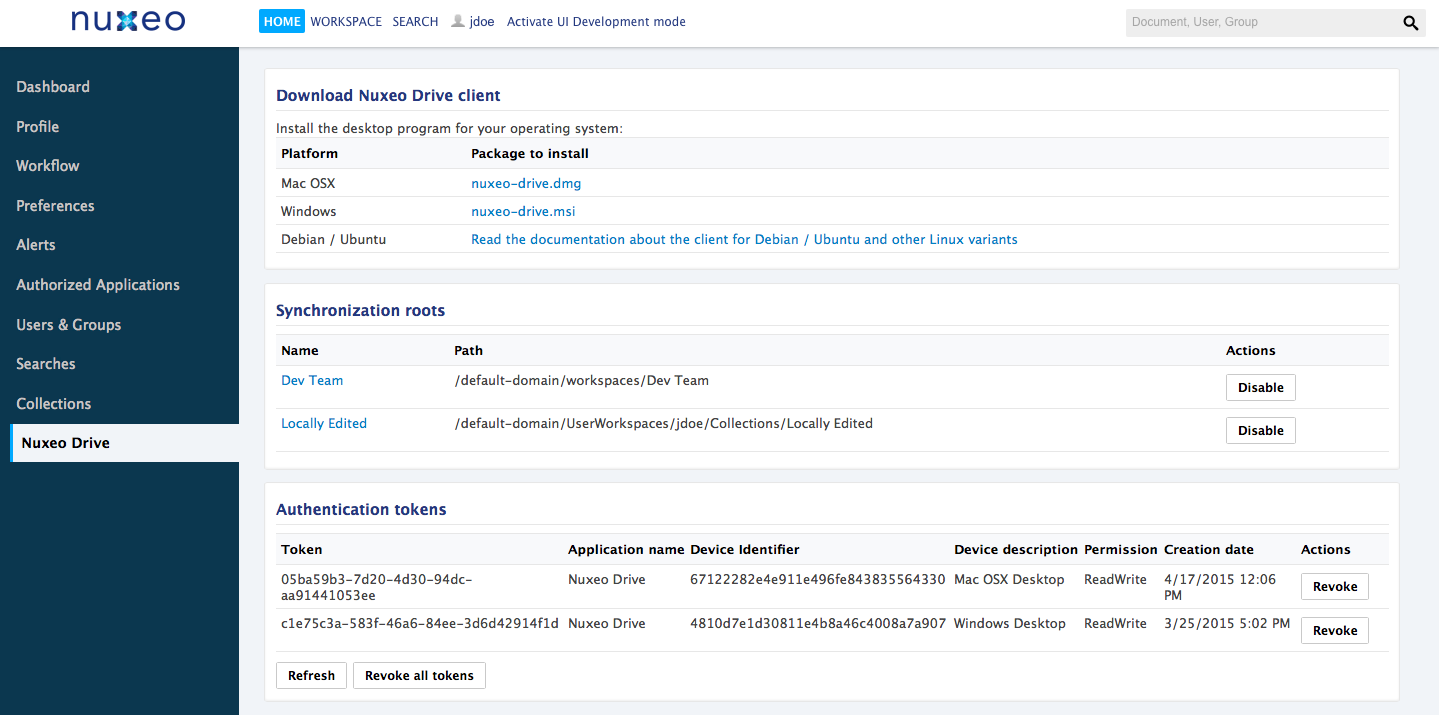

Web UI
To synchronize a space, in the Nuxeo Platform, click on the icon ![]() .
The icon becomes orange
.
The icon becomes orange ![]() . Documents inside the synchronized space have a Drive local edit icon
. Documents inside the synchronized space have a Drive local edit icon ![]() .
.
The folder and all its content is now available in your local Nuxeo Drive folder. You can now create, edit, delete documents from your computer. If you only have Read permissions, documents are in read-only mode.
On your Home Nuxeo Drive tab, the space is displayed in the "Synchronization root" section. This is where you can see all the spaces you have synchronized with Nuxeo Drive.
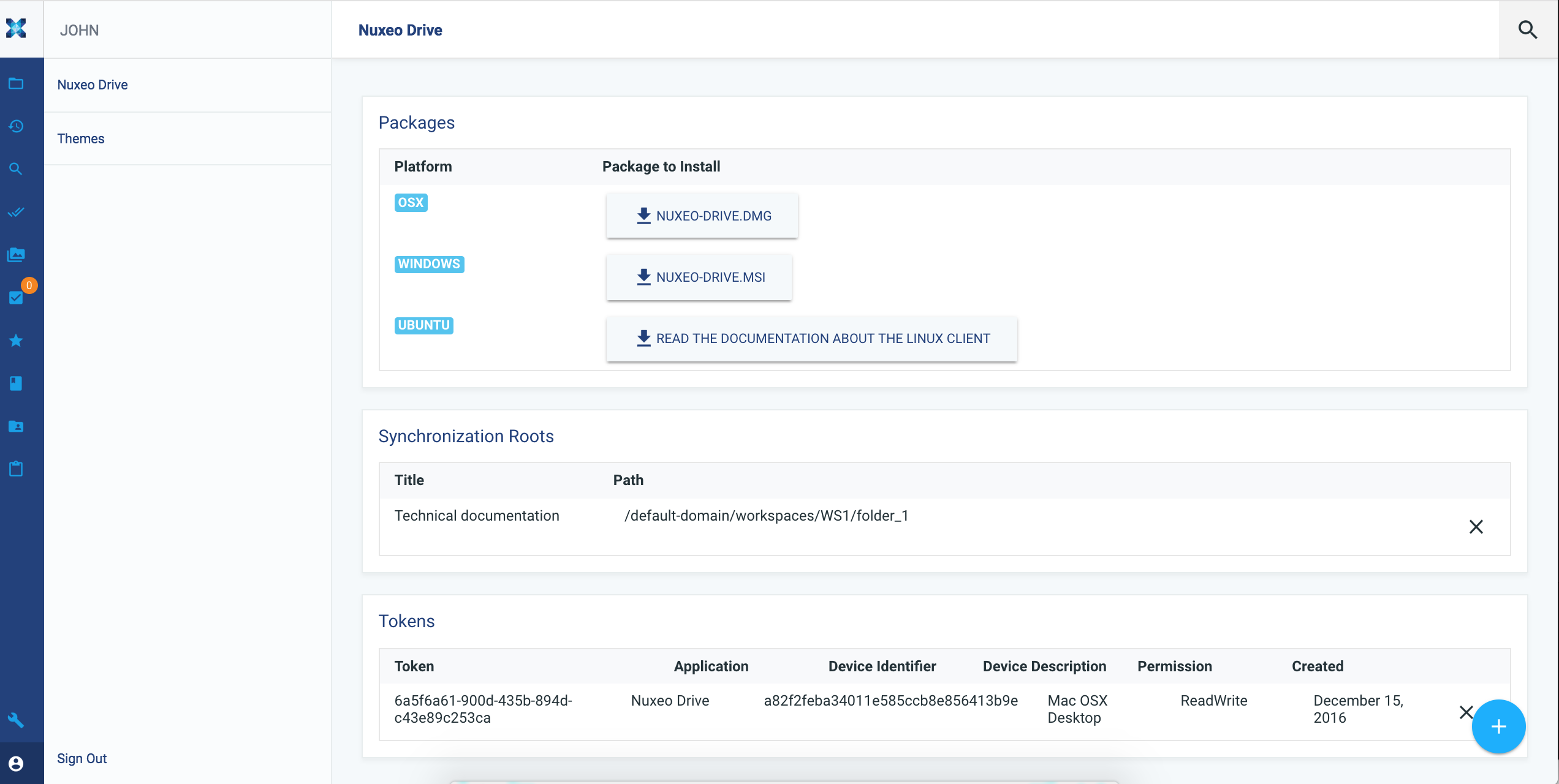

Suspending Synchronization
If a synchronized folder holds big document or a large amount of documents, synchronization can take some time and some computer resources. It is then possible to prevent this by suspending synchronization until a more convenient time.
To suspend synchronization:
- Click on the Drive icon in the system tray.
- Click on the icon
 and click on the Suspend menu item.
If Nuxeo Drive is currently synchronizing, synchronization is completed before suspending Nuxeo Drive.
The Drive icon becomes grey as long as synchronization is suspended:
and click on the Suspend menu item.
If Nuxeo Drive is currently synchronizing, synchronization is completed before suspending Nuxeo Drive.
The Drive icon becomes grey as long as synchronization is suspended:  .
.
To resume synchronization:
- Click on the Drive icon
 in the system tray.
in the system tray. - Click on the icon
 and click on the Resume menu item.
The Drive icon becomes blue again and synchronization is available again.
and click on the Resume menu item.
The Drive icon becomes blue again and synchronization is available again.
Unsynchronizing a Folder
There are two ways to desynchronize a folder.
- From the server, when you desynchronize a folder all its content is desynchronized from all the devices where you use Drive.
- From the client, when you desynchronize a folder you can do it in detail and choose to locally deactivate synchronization of different folders for the current device.
Deactivating Synchronization Locally (Client)
By default, once you have synchronized a folder all its content (files and folders) are synchronized. But you can deactivate synchronization locally on some folders. This feature enables you to manage the storage space dedicated to the synchronization, which is especially useful if you use a device with a low-storage capacity.
Clicking on the Select sync folders button in the Settings window shows the Nuxeo Drive Filters windows from which you can unselect folders to unsynchronize. Unselected folders remain displayed to you can easily reselect and synchronize them back. They are still marked as synchronized on your web UI.
Unsynchronizing Folders (Server)
JSF UI
Unsynchronizing a folder is only possible from the Nuxeo Platform web interface. You can only unsynchronize the whole synchronized space, i.e. from the synchronization root  : it is not possible to unsynchronize a child
: it is not possible to unsynchronize a child  . Clicking on the icon
. Clicking on the icon  brings you back on the space from which the synchronization is done.
brings you back on the space from which the synchronization is done.
To unsynchronize a space, in the Nuxeo Platform interface, click on the icon  .
The icon becomes gray, indicating that the space is no longer synchronized. The folder and its content is no longer available from your Nuxeo Drive folder and from the Home Nuxeo Drive tab.
.
The icon becomes gray, indicating that the space is no longer synchronized. The folder and its content is no longer available from your Nuxeo Drive folder and from the Home Nuxeo Drive tab.
Web UI
Unsynchronizing a folder is only possible from the Nuxeo Platform web interface. You can only unsynchronize the whole synchronized space, i.e. from the synchronization root ![]() .
.
To unsynchronize a space, in the Nuxeo Platform interface, click on the icon ![]() .
The icon becomes gray, indicating that the space is no longer synchronized. The folder and its content is no longer available from your Nuxeo Drive folder and from the Home Nuxeo Drive tab.
.
The icon becomes gray, indicating that the space is no longer synchronized. The folder and its content is no longer available from your Nuxeo Drive folder and from the Home Nuxeo Drive tab.
Managing Documents
Creating Documents
From the Platform
When you create a new document in a Drive-synchronized folder from the Platform, it is automatically created in your Drive folder at the next synchronization. If you created a file or a picture, what is in the Drive folder is the attachment (mydoc.doc for instance for Nuxeo document whose title could be "My document").
From the Local Nuxeo Drive Folder
Adding a new document in a Drive-synchronized folder from your computer will create the document in the Platform workspace at the next synchronization. The document title is the name of the original file, and no metadata is filled in.
Editing Documents
Versioning
When you edit a document, either from your Nuxeo Drive folder or using the online editing, a new version is automatically created on the Platform and the version number is updated:
- If you are not the last contributor of the document
- Or if your last edit is more than an hour ago
Then, if your document's version was 1.0 before modification for instance, it automatically becomes 1.1+ after you edited it from the Nuxeo Drive folder and the 1.1 is archived as it is created. Otherwise, a simple modification is done on the document and logged in the document's History.
See the page How to Customize Nuxeo Drive Versioning Policy to change this behavior.
Editing a Locked Document
In the Nuxeo Drive folder, no indication is available if a document has been locked from the Nuxeo Platform interface. Nuxeo Drive won't prevent you from working on a document, but it will not update the locked document on the server if you are not the locker.
Managing Conflicts
It can happen that a document is edited by several users locally at more or less the same time. Or that a user edits a document locally in offline mode, and that the same document is modified during that offline period. When Nuxeo Drive tries to synchronize the document it detects that there may be a conflict between the different modifications of the document.
Clicking on the conflict message shows you the details and how to resolve the conflicts.
- Use local: The document in your Nuxeo Drive folder overrides the document on the server.
- Use remote: The document on the server is downloaded in your Nuxeo Drive folder and overrides your local version.
- Duplicate files: A new document is automatically created for the offline edited document. Its title is suffixed with
__1: "my document__1.odt" for instance. Two documents are now available in the Nuxeo Platform and in the local Nuxeo Drive folder.
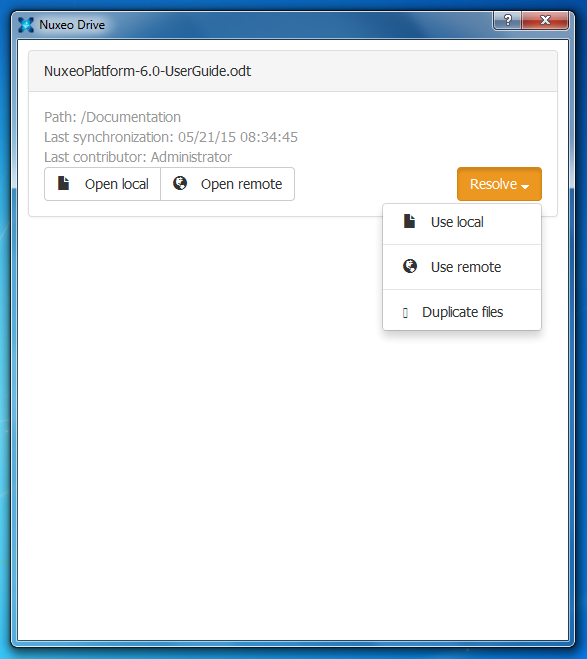

Online Editing with Direct Edit
Direct Edit enables you to edit any of your document's content from their Summary tab even if they are not synchronized. To be able to use correctly Direct Edit you need the Drive addon on your server and you must turn on Drive on your computer. This saves you the fastidious steps of opening your document, modify it and reimport it on your platform.
Direct Edit icon
JSF UI: 
Web UI: ![]()
To edit a document locally from the web interface:
On the document in the Nuxeo Platform, click on the Direct Edit icon on the Summary tab on JSF UI and on document View on Web UI. The document opens in its native application (OpenOffice.org for an .odt file for instance).
If you plan to work on the document for some time, you can easily lock it from the Metadata edit popup (see the section Metadata Edit).
Note that depending on your OS and the file format, the document can be automatically locked.This is still a beta feature of Direct Edit, known to currently work on OS X and Windows.
- Edit the document and save the modifications. Modifications are saved in the Nuxeo Platform directly.
- Close the document.
Direct Edit Limitations
- Prior to Nuxeo Platform 6.0, online editing is available only in synchronized folders.
- Under Windows, nothing happens if you click on the Direct Edit icon without having Drive installed and running on your computer.
Renaming Documents
Renaming a document from the server, i.e. changing the document's title, has no impact on the file's name in your Nuxeo Drive folder, which is the document's attachment.
Renaming a document from the Nuxeo Drive folder renames the document and its attachment on the server if they have the same name. If the document title is different from the attachment's, then only the attachment is renamed.
Editing Metadata
Metadata edit is available starting from Nuxeo Platform 6.0.
Metadata Edit allows you to edit the metadata of your document from your desktop.
- Go to your Nuxeo Drive folder on your computer.
- Right-click on the name of the document that you want to edit.
- Click on Nuxeo Drive.
A window pops up where you can also locked the document, get the permanent link or add your document to your favorites.
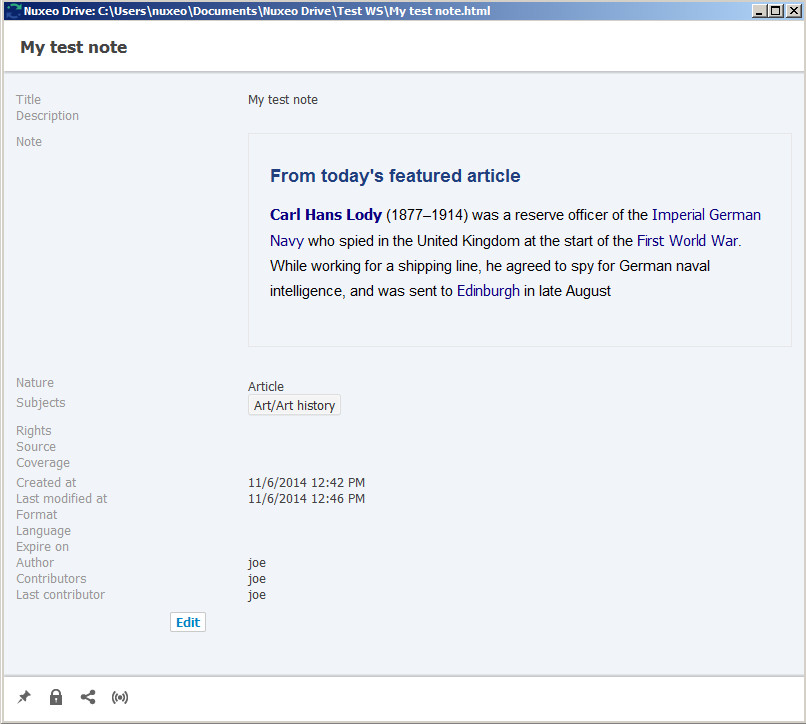

- Click on Edit and modify your document,
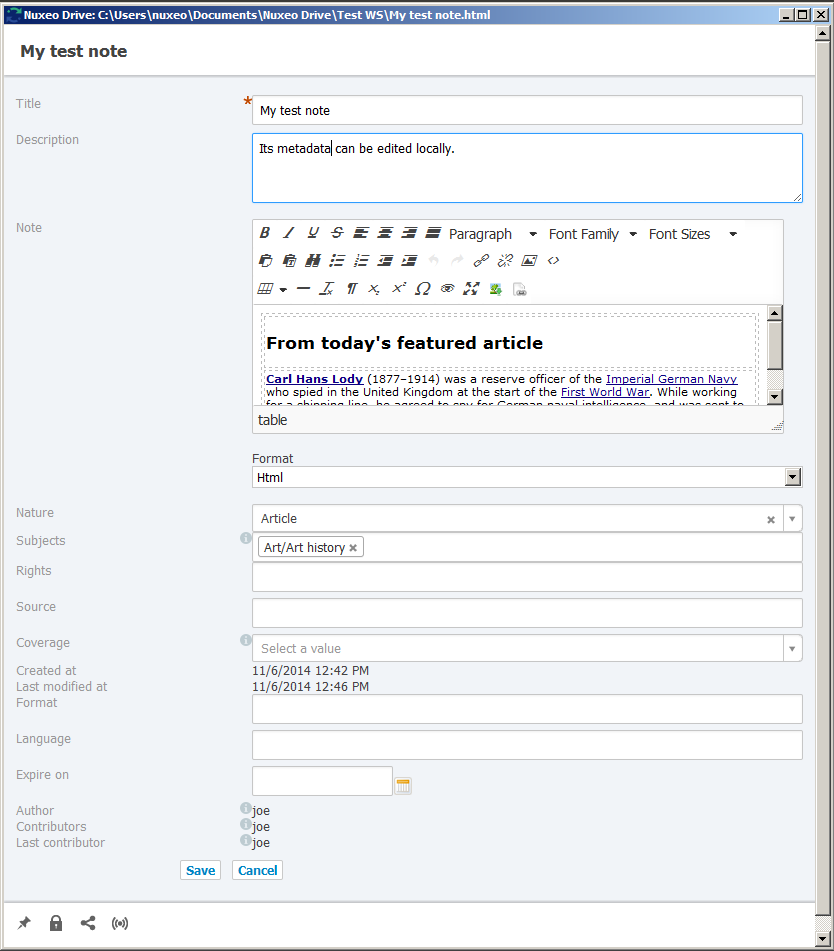

- Click on Save.
Moving Documents
You can move documents either from your local Nuxeo Drive folder or from the Platform. When you move documents between two synchronized spaces, the move is done on the other side, whether you move documents from the Platform or from your Drive folder.
When you move a document from a Drive-synchronized folder to an unsynchronized one, the behavior is different if you move the document from the Platform or from your local folder.
- If you move the document from the Platform, the document is not available anymore in your local folder.
- If you move the document from your local folder, the document is deleted on the Platform and moved into the folder's trash. In the document's history, the deletion is tagged with the Nuxeo Drive category.
Deleting Documents
When you delete documents from the Platform, they are deleted from your local Drive folder at the next update.
When you delete a document from your local Drive folder, the document is deleted on the Platform and moved into the folder's trash. In the document's history, the deletion is tagged with the Nuxeo Drive category.
Unauthorizing a Drive Client to Access the Nuxeo Platform
When you start Nuxeo Drive on your computer for the first time, you need to provide your credentials so the Drive client can communicate with the Nuxeo Platform. This creates an authentication token on the Platform, that is displayed on the Nuxeo Drive tab in the Home on JSF UI and on the Nuxeo Drive part of User Settings on Web UI.. If you want to unauthorize a Drive client to access the Nuxeo Platform using your credentials, for instance because you changed your computer, you can revoke this authentication token. The Nuxeo Drive client will then require the credentials to be updated to connect to the Nuxeo Platform.
To revoke an authentication token:
- On the Nuxeo Platform, click on the Nuxeo Drive tab (see locations above).
Click on the Revoke button of the token to be revoked. Several elements are displayed to help you identify the right token:
- the device description: whether it is a Mac OS client, Windows client, Linux client;
- the creation time: date and time at which the token was created, i.e. the date and time at which you provided it with your credentials.
- In the window that pops up, click on OK to confirm. The Nuxeo Drive client cannot communicate with the Nuxeo Platform and switches to offline. When you click on the Drive icon, it says "Update credentials (required)".
Customization
You can override classes to implement your own Nuxeo Drive following the developer guide.